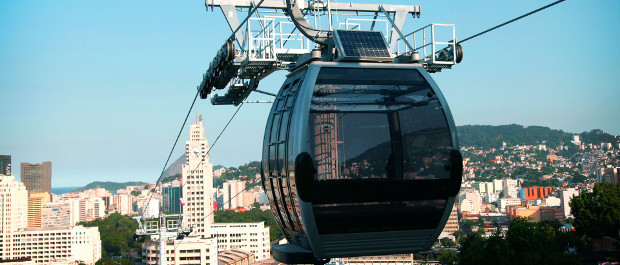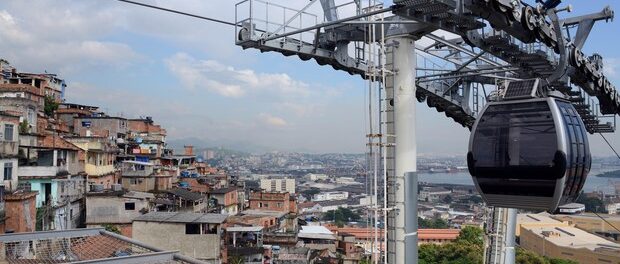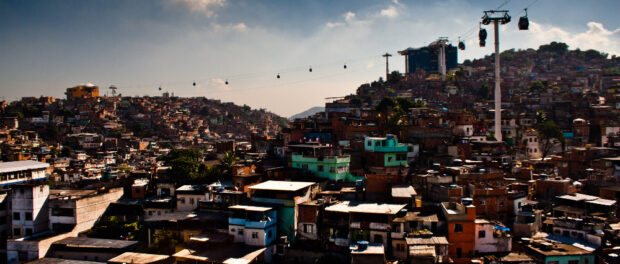
Since its first run in 1912, the famous bondinho, or cable car, has made countless trips taking millions of tourists to soak in panoramic views of Rio de Janeiro from the top of the iconic Sugarloaf mountain. Meanwhile, since completion in 2012, the cable car system in Rio’s most historic favela, Morro da Providência, has only made a handful of test runs. Only now, more than 18 months after completion, has the launch been announced, leading many to skepticism regarding intentions, asking “Why Now?” Cable cars as innovative urban mobility solutions–as Providência is touted to be–have recently become prevalent in Latin America. But there are signs the new ones in Rio’s favelas are mainly about continuing the legacy of tourism–and politics.
The Urban Development Company of the Port Region of Rio de Janeiro (CDURP) announced on Thursday June 19 that the Providência cable car’s launch was only dependent on further testing after a change was made to the generator that supplies energy to the cars. The Concessionária Porto Novo will be responsible for operating the service according to the CDURP. The city government said in May that the system would be launched the same month explaining no company had yet been chosen for operation and maintenance. Progress has been made since, however, with the launch date now announced for tomorrow, July 2nd.
The long delayed project was funded under the city government’s Morar Carioca program intended to upgrade infrastructure and promote social integration of Rio’s favelas. Of the R$163 million invested in Providência through Morar Carioca, the construction of the cable car accounts for nearly half the spending at R$75 million. The cable car is listed under the special projects on the Porto Maravilha official website. Porto Maravilha (“Marvelous Port”) is a separate city government program to regenerate the Port region surrounding Providência prior to the 2016 Olympics. Longtime resident Maurício Hora spoke at an event in April about the challenging disparity of Providência attempting to improve basic services in the favela through Morar Carioca, while the entire adjacent Port region receives so many resources through Porto Maravilha.
In April 2013, Mayor Eduardo Paes said the cable car would serve two functions: “[It] will serve as transportation for the local population, but will also be a new tourist destination.” Residents of Providência have already voiced concerns that the cable car is primarily intended for the latter and is not an urgent priority for the community. Construction of the system came at the expense of the main public space in the favela, the Praça Américo Brum, and most importantly, people’s homes. Orginally, 832 homes were marked for demolition. A court order in August 2013 froze all public works in Providência except for the cable car due to a lack of public consultation.
There are three stations for the system, covering a total of 721 meters. The first station at Central do Brasil railway, metro and bus station links to Praça Américo Brum in Providência (but not the highest point in the community). The Providência station has a viewing platform looking out to the port and down to Samba City, the site of the third station. Although steep, it is only a fifteen minute ascent by foot from Central do Brasil to the Praça Américo Brum, and there are already kombi van services running regularly that transport residents and their cargo, as well as a mototaxi service.
According to city officials, when the cable car is operational it will have the capacity to transport 1,000 from one side to the other every hour, with trips running 8 minutes. Each cable car can accommodate ten passengers.
The cable car in Providência was the second constructed in Rio with the stated purpose of improving mobility in favelas, based on the pioneering example in Medellín, Colombia. While Complexo do Alemão’s R$210 million system has at least been operational since its construction in 2011 and has provided transport for many residents, problems remain. The capacity targets projected by the state and federal governments have not been met and Alemão still has urgent needs, such as water and sanitation, that residents consider more critical.
Last year, President Dilma Rousseff visited Rocinha and announced it would be the third favela to receive a cable car. Upon learning that the works would be realized through the second phase of the federal Growth Acceleration Program (PAC), residents mobilized quickly to voice their disapproval of the plans. Community organization Rocinha Sem Fronteiras (Rocinha Without Borders) was instrumental in putting forward the neighborhood’s demand that the PAC-2 instead be put toward the urgent priorities of a water and sanitation network, as originally promised but never delivered in theimplementation, PAC-1, beginning in 2006.
A closer look at the original model in Medellín reveals why the system has been so much better received there. Empresas Públicas de Medellín (E.P.M.), the city’s utility company responsible for water, sanitation, gas and electricity, is constitutionally mandated to deliver these services to the entire population, meaning that communities did not have to forgo basic services in favor of the cable car system. Another critical factor is community participation. Residents of Medellín were involved in the decision-making process to a much greater extent than those in Rio, where in some cases residents were told at the last moment their house was slated for demolition rather than asking the community if they needed a cable car.
Rio de Janeiro has a long and successful history with a cable car as a tourist attraction. The new phenomenon of cable cars as an urban mobility solution, however, are of highly questionable success. Although mobility and tourism need not be mutually exclusive, in Rio’s favelas authorities appear to be pursuing the latter, while masquerading the infrastructure as the former.


